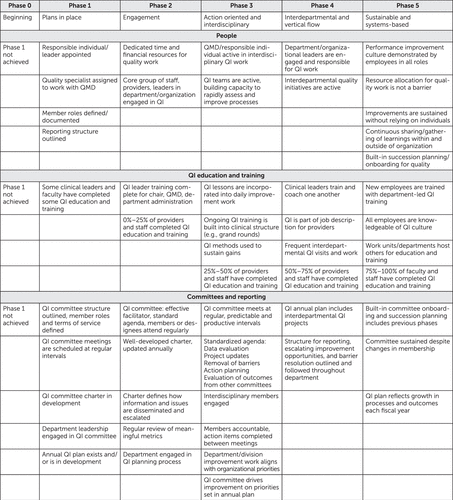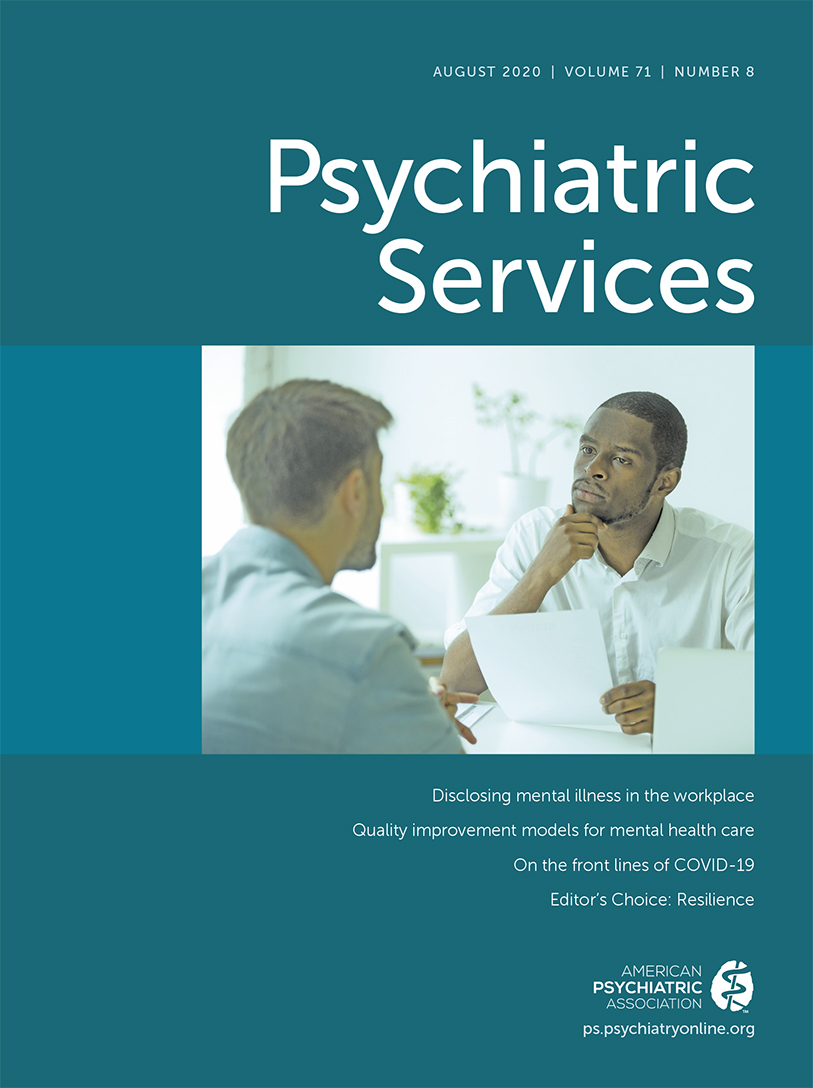Use of a Model Maturity Matrix to Build a Quality Improvement Infrastructure for Psychiatric Care
Abstract
Despite a call to action by accreditation bodies and payers alike, the infrastructure needed to continuously improve the quality and safety of behavioral health care has been slow to develop. The causes of this are complex and multifactorial yet likely include underdeveloped leadership and capacity to sustainably improve the quality of psychiatric care. This article proposes the use of a quality improvement maturity matrix to serve as both an implementation strategy and a self-assessment measure to strategically guide this infrastructure development. The matrix describes six phases of development across three domains that are generalizable to various behavioral health care settings.
HIGHLIGHTS
Building workforce capacity and sustaining quality improvement in psychiatry require a purposeful strategy and intentional workforce engagement.
The proposed maturity matrix is a phased, strategic planning tool to gradually build and advance organizational quality infrastructure for psychiatric settings through education, leadership development, and resource investment.
Developing a quality infrastructure by building psychiatric workforce capacity can harness the power of quality improvement methodologies to meet quality goals.
The importance of quality improvement (QI) in the delivery of health care is well recognized. Quality in health care, as defined by the Institute of Medicine (IOM), is the direct correlation between the level of improved health services and the desired health outcomes of individuals and populations (e.g., high-quality care is safe, effective, patient centered, timely, efficient, and equitable) (1).
Decades after multiple IOM reports called for action to improve the quality and safety of the nation’s health care and specifically identified persistent gaps in the quality of behavioral health care, descriptions of improvement efforts in behavioral health have been limited (2, 3). There are numerous factors contributing to this slow growth, including the lack of a well-developed psychiatric quality infrastructure as well as organizational, economic, societal, and political barriers. To overcome these barriers and build a sustainable culture of quality and safety in behavioral health, our field must purposefully engage the psychiatric workforce to build more capacity for sustainable improvement. These efforts may include enhanced education and training in QI, the development of dedicated committees and reporting structures, benchmarks for accountability, leadership, and the allocation of time and resources to sustain these efforts. In this article, we highlight use of a QI maturity matrix (QIMM), a novel approach to building organizational infrastructure for the advancement of quality in psychiatric services.
QIMM
A maturity matrix is a tool used to analyze organizational limitations and align processes with strategic goals (4). The proposed QIMM was developed in response to a lack of methodology to measure QI infrastructure, a critical factor in carrying out processes within any QI methodology. The described QIMM was developed by medical directors with oversight of departmental quality initiatives and by other quality leaders (e.g., chief medical officers, quality specialists, and nurses) during routine monthly organizational quality meetings at an academic medical center. Adult learning methodologies, research, and critical assessment of variation between departments were used in the development of the tool (5). The QIMM describes six phases of quality infrastructure development across the domains of people, training, and committees and reporting. The phases of development begin with putting “plans in place,” followed by increasing levels of engagement, creating an action-oriented culture, and offering work that is both interdisciplinary (e.g., nursing, social work, and psychology) and interdepartmental. Although there is not a one-size-fits-all approach, the QIMM is intended to facilitate the strategic development of organizational QI depth and breadth when used as both an implementation strategy and a self-assessment measure. For example, departments may use the matrix to perform an annual gap analysis, resulting in an action plan to achieve the next phase of infrastructure maturity for each fundamental component of the matrix. As with any implementation process in health care, the QIMM is most likely to succeed when adopted by motivated and able organizations responding to external incentives and policies. See Figure 1 for full details of the QIMM.

FIGURE 1. Quality improvement infrastructure maturity matrixa
aQMD, quality medical director; QI, quality improvement.
Stages of Development
Early
Phase 0, which is described as having not achieved phase 1, is a state with little to no formal quality infrastructure in place. This level of development limits the ability of a unit or organization to carry out standard QI methodologies and improve care. Achievement of phase 1 entails the behavioral health organization or department having an established plan. Initial plans may include defining QI committee member roles and reporting structure, as well as identifying a responsible quality leader (e.g., medical director of quality). In these early phases, it is likely that few, if any, staff or providers will have engaged in formal QI education and training, although this should be a focus of future strategic growth. A psychiatric QI committee may be established and meetings scheduled at regular intervals. In addition, organizational or departmental leadership are engaged, and plans are made to continue to actively build and support quality infrastructure development. Furthermore, QI committee structure, member roles, and terms of service are then established in a charter that is reviewed and updated at regular intervals (e.g., annually).
Intermediate
Once the basic standard work and structure are in place, phases 2 and 3 of development focus on expanding education, engagement, accountability, and active QI work. Consistent with achievement of phase 2, leadership must dedicate time and financial resources to support psychiatric QI efforts. Engagement should be expanded by increasing access to QI education, with a goal to train up to 25% of leaders, staff, and providers before phase 3. Although education on general QI concepts is critical, additional training specific to behavioral health may further enhance engagement. Such examples may include improving suicide risk screening, implementing measurement-based care, and formalizing morbidity and mortality reviews. This approach to systematic training and education facilitates the development of interdisciplinary QI teams that can actively build capacity and engage in rapid process improvement while providing data that can be used to remove barriers and strategically plan for the future. In phase 3, QI committee members complete action items between meetings, carry out established responsibilities, and report back at regular intervals through clear lines of communication. Ultimately, this moves the organization toward vertical integration, as unit or departmental QI efforts align with larger organizational priorities.
Mature
Phases 4 and 5 of the QIMM focus on interdepartmental growth and vertical organizational flow to create a sustainable and systems-based infrastructure for psychiatric quality. Achieving this stage of development typically requires years of sustained effort. In phases 4 and 5, QI efforts are included within the job descriptions for leaders, staff, and providers. Clinical leaders train and coach peers and staff in critical QI concepts and processes. The QI infrastructure builds in plans for the reporting and escalating of improvement opportunities and barrier resolution beyond the local work unit. Nearly all staff and providers (e.g., 75%−100%) have engaged in formal QI education and training. Furthermore, this well-trained workforce incorporates these lessons into their daily work in a meaningful and effective manner. Phase 5 is an ideal state in which all employees identify with and work within an established culture of quality and safety, and resource allocation is no longer a significant barrier to QI. Improvements and infrastructure growth are sustained without relying on specific individuals, and knowledge sharing extends beyond the organization into community systems of care. Succession planning and onboarding are integrated such that the psychiatric quality infrastructure is sustained despite changes in membership or leadership. Finally, QI work reflects growth in goals, processes, and outcomes over time, aligning with growth along the phases of the QIMM.
Conclusion
To achieve quality and safety goals, we advocate for a more intentional engagement of the psychiatric workforce to build a robust quality infrastructure adept at continuously delivering safe, effective, patient-centered, and equitable psychiatric care. The development of quality infrastructure—by means of building psychiatric workforce capacity and QI literacy and expertise— can harness the power of current QI methodologies to meet these goals, while meeting the demands of accreditors and payers as psychiatry moves toward value-based care.
1 . Crossing the Quality Chasm: A New Health System for the 21st Century. Washington, DC, National Academies Press, 2001. https://www.ncbi.nlm.nih.gov/books/NBK222274Google Scholar
2 . America’s Health in Transition: Protecting and Improving Quality. Washington, DC. National Academies Press, 1994. https://www.ncbi.nlm.nih.gov/books/NBK231302Google Scholar
3 . Improving the Quality of Health Care for Mental and Substance-Use Conditions. Washington, DC, National Academies Press, 2006. https://www.ncbi.nlm.nih.gov/books/NBK19830Google Scholar
4 : Systematic literature review of quality maturity matrix. Total Qual Manage Bus Excell (Epub ahead of print, Dec 14, 2018)Google Scholar
5 : Learning in Adulthood: A Comprehensive Guide, 3rd ed. San Francisco, Jossey-Bass, 2007Google Scholar



